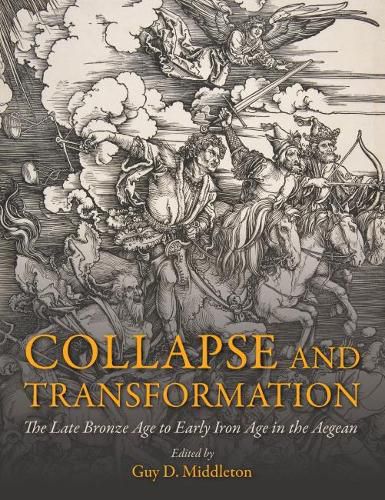Readings Newsletter
Become a Readings Member to make your shopping experience even easier.
Sign in or sign up for free!
You’re not far away from qualifying for FREE standard shipping within Australia
You’ve qualified for FREE standard shipping within Australia
The cart is loading…






The years c. 1250 to 1150 BC in Greece and the Aegean are often characterised as a time of crisis and collapse. A critical period in the long history of the region and its people and culture, they witnessed the end of the Mycenaean kingdoms, with their palaces and Linear B records, and, through the Postpalatial period, the transition into the Early Iron Age. But, on closer examination, it has become increasingly clear that the period as a whole, across the region, defies simple characterisation
there was success and splendour, resilience and continuity, and novelty and innovation, actively driven by the people of these lands through this transformative century. The story of the Aegean at this time has frequently been incorporated into narratives focused on the wider eastern Mediterranean, and most infamously the ‘Sea Peoples’ of the Egyptian texts. In twenty-four chapters written by specialists, Collapse and Transformation instead offers a tight focus on the Aegean itself, providing an up-to date picture of the archaeology ‘before’ and ‘after’ ‘the collapse’ of c. 1200 BC. It will be essential reading for students and scholars of the Aegean and eastern Mediterranean regions, as well as providing data and a range of interpretations to those studying collapse and resilience more widely and engaging in comparative studies. Introductory chapters discuss notions of collapse, and provide an overview the Mycenaean collapse. These are followed by twelve chapters, which review the evidence from the major regions of the Aegean, including the Argolid, Messenia, and Boeotia, Crete, and the Aegean islands. Six chapters then address key themes: the economy, funerary practices, the Mycenaean pottery of the mainland and the wider Aegean and eastern Mediterranean region, religion, and the extent to which later Greek myth can be drawn upon as evidence or taken to reflect any historical reality. The final four chapters provide a wider context for the Aegean story, surveying the eastern Mediterranean, including Cyprus and the Levant, and the themes of subsistence and warfare.
AUTHOR: Guy D. Middleton is a Senior Researcher in the Czech Institute of Egyptology, Charles University, Prague, and a Visiting Fellow in the School of History, Classics and Archaeology at Newcastle University. His PhD on the Mycenaean collapse c. 1200 BC was completed at Durham University; he has a BA (Hons) in Ancient History and Archaeology and an MA in Museum Studies from Newcastle University.
$9.00 standard shipping within Australia
FREE standard shipping within Australia for orders over $100.00
Express & International shipping calculated at checkout
The years c. 1250 to 1150 BC in Greece and the Aegean are often characterised as a time of crisis and collapse. A critical period in the long history of the region and its people and culture, they witnessed the end of the Mycenaean kingdoms, with their palaces and Linear B records, and, through the Postpalatial period, the transition into the Early Iron Age. But, on closer examination, it has become increasingly clear that the period as a whole, across the region, defies simple characterisation
there was success and splendour, resilience and continuity, and novelty and innovation, actively driven by the people of these lands through this transformative century. The story of the Aegean at this time has frequently been incorporated into narratives focused on the wider eastern Mediterranean, and most infamously the ‘Sea Peoples’ of the Egyptian texts. In twenty-four chapters written by specialists, Collapse and Transformation instead offers a tight focus on the Aegean itself, providing an up-to date picture of the archaeology ‘before’ and ‘after’ ‘the collapse’ of c. 1200 BC. It will be essential reading for students and scholars of the Aegean and eastern Mediterranean regions, as well as providing data and a range of interpretations to those studying collapse and resilience more widely and engaging in comparative studies. Introductory chapters discuss notions of collapse, and provide an overview the Mycenaean collapse. These are followed by twelve chapters, which review the evidence from the major regions of the Aegean, including the Argolid, Messenia, and Boeotia, Crete, and the Aegean islands. Six chapters then address key themes: the economy, funerary practices, the Mycenaean pottery of the mainland and the wider Aegean and eastern Mediterranean region, religion, and the extent to which later Greek myth can be drawn upon as evidence or taken to reflect any historical reality. The final four chapters provide a wider context for the Aegean story, surveying the eastern Mediterranean, including Cyprus and the Levant, and the themes of subsistence and warfare.
AUTHOR: Guy D. Middleton is a Senior Researcher in the Czech Institute of Egyptology, Charles University, Prague, and a Visiting Fellow in the School of History, Classics and Archaeology at Newcastle University. His PhD on the Mycenaean collapse c. 1200 BC was completed at Durham University; he has a BA (Hons) in Ancient History and Archaeology and an MA in Museum Studies from Newcastle University.